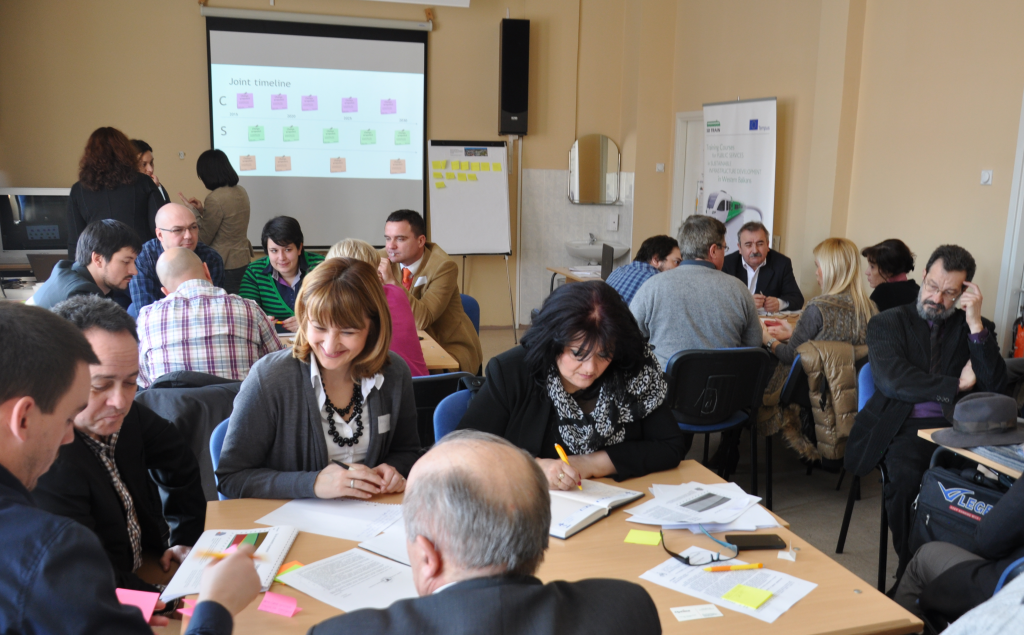
The city of Niš recognises the potential that democratic decision-making has in terms of bringing about an ambitious energy transition focused on fighting energy poverty. All the relevant actors are now working together on the transition, bridging initial differences of opinion about democratic ownership models and the need to access external resources. By integrating road maps and action plans with a long-term vision, Niš has become a pilot city and role model for other cities in the region.
A long-term vision for energy transition
Situated in the Nišava valley in the South of the country, Niš is the third largest city in Serbia, a country with an energy sector deeply affected by its dependency on fossil fuel imports, especially concerning natural gas and petroleum brought in to complement Bulgaria’s own production from coal combustion. Consumers also face high levels of energy poverty.
The municipality is determined to bring about an energy transition, so that the energy system is democratic, clean, social, efficient and renewable. To this end energy policies in Niš are embedded in a set of interwoven action plans and road maps.
Niš was the first Serbian city to adopt and implement a Sustainable Energy Action Plan (SEAP), which it did in 2014. This defines the concrete actions, responsibilities and timings needed to achieve the authority’s energy consumption and CO2 emissions reduction targets. In its SEAP, the city has aligned its target with the EU target to reduce energy consumption by 21% in 2020 compared to the baseline of 2010.
As a signatory of the Covenant of Mayors (COM), the city’s agenda until 2030 will be outlined in a Sustainable Energy and Climate Action Plan (SECAP), which is due to be adopted in 2020 as a follow up to the SEAP. The SECAP provides a template for individual action plans based on the SEAP and draws on research from the European Commission Joint Research Centre (JRC), allowing municipalities to monitor and analyze relevant data as a basis for integrated climate and energy management ([i]).
Niš is currently participating in the project TOMORROW, financed by the EU programme Horizon 2020, and is developing a long-term Energy Transition Road Map 2050. The road map addresses the ‘decarbonisation of the economy’ and sets out a route for pushing back against climate change by engaging citizens and building resilient communities. The project is led by Energy Cities, a network of 1,000 municipalities engaged in energy transition ([ii]). Project partners include the Dutch Research Institute for Transition (DRIFT) and several other European cities ([iii]).
Closing the gap: Towards sustainable district heating and citizens’ participation
In 2013, the city switched the billing system for district heating from an approach based on the area of a property to one that measures monthly consumption. This change was introduced to increase transparency and fairness, but many people objected to it, especially low-income households with poorly insulated homes who faced higher costs. Many residents demanded disconnection from the district hearting system, because they felt the change in the billing system further entrenched energy poverty, which is already a huge problem in Serbia (the second most affected European country after Bulgaria) ([iv]).

Facing increasing tensions between citizens on one side and the municipality and the heating company on the other, the administration decided to invite residents to be part of a democratic process to find a solution. A citizens’ organisation that represents city dwellers are now represented in a commission for price change approval. It also sits on the supervisory board of the heating company, where the representative gets to take part in management meetings. This new, democratic structure has empowered the municipality’s capacity to drive the local energy transition forward for everyone’s benefit. For example, the public company effectively consulted users to improve its billing system. Citizens that receive district heating now pay a bit more in the winter months and a bit less during summer, reflecting their preferences.
Niš did a study to move Towards Sustainable Heating 2030, which they presented at the ENLARGE project (Energies for Local Administrations to Renovate Governance in Europe) ([v]). It includes finding heating solutions for buildings that are not connected to the district heating system. Other goals are to increase the share of renewable energy used by the district heating system and decrease greenhouse gas emissions. The first steps have already been taken in Niš by upgrading one of the heating plants to gas instead of oil. The district heating company is also testing geothermal heat extraction from a 300m-deep well.
Many challenges remain however, especially Serbia’s dependency on importing natural gas from Russia, and fluctuations in global market prices. Solutions could include switching to biomass powered by wood waste and using underground water sources to generate geothermal energy. But in terms of energy efficiency, the district heating system is already one of the most efficient in Serbia. The city and public district heating company are also exploring the possibility to create an Energy Saving Company (ESCO) to be in charge of future retrofitting of residential buildings.
Public or private? Risks and benefits of ESCOs
The administration is already developing a public-private partnership (PPP) proposal in order to appoint an Energy Saving Company (ESCO) to upgrade the public lighting system. Yet the fact that ESCO agreements involve private sector participation is a sensitive topic when it comes to the operation of public services. PPPs, which are heavily promoted by international organisations such as the World Bank, tend to be chosen by municipalities with limited alternative material and financial resources. However, the private companies involved are often accused of not delivering on the promises they have made. For example, they may drive prices up and service quality down, leaving municipalities dealing with negative impacts.However – although the situation differs from case to case – ESCOs could be seen as an alternative to the conventional form of PPPs, as they contain an explicit guarantee of the service performance expected from the private partner. The Energy Performance Contracting (EPC) clause is the central part of an ESCO agreement – it ensures that the private partner can be held accountable if agreements are not fulfilled. And while most PPPs tend to leave risks and costs up to the public authority, an ESCO can be specifically designed to allow alterations to contracts and deny remuneration if the private partner does not deliver the services agreed in the contract. Additionally, municipalities may benefit from the contract, as ESCOs may enable the municipality to access the necessary finance and cover operational costs by providing a savings guarantee ([vi]).
The design and creation of an ESCO can be addressed in collaboration with the citizens’ organisation that has been formed in the wake of the protest against the new billing system.
Hence, following the billing upheaval, the company has been capping heating bills for families that due to poor insolation use 20% more energy than the average household. So for the moment, the city subsidises their bills but once these homes have been retrofitted – for example, by means of an ESCO – such financial support can be phased out as retrofitted homes tend to use substantially less heating.
Energy efficiency in public and residential buildings
Many public buildings in the city are also not well insulated and have outdated heating and cooling systems. This problem has been exacerbated by the fact that the buildings have not been maintained well. In order to increase energy efficiency in school buildings, the city has been working with the German Development Agency (GIZ). Based on a cost-benefit assessment and software-based technical documentation, a priority list of proposed energy efficiency measures has been drafted. The use of technical data facilitates the efficient use of limited financial funds. This programme is also educational, and children and school staff are invited to learn about energy efficiency.

A memorandum between the city and GIZ sets out the conditions for close cooperation. Activities relating to the identified priorities are expected to be implemented in consultation with donors from the end of 2019 onwards ([vii]). The city has already started installing solar panels on the rooftop of the collective kitchen, heating the water to provide the lunches for over 20 kindergartens. Moreover, at least 12 more schools and kindergartens in the city are due to be retrofitted in accordance with sustainability standards.
An additional Memorandum of Understanding has been signed by the cities of Niš, Pancevo, and Cacak and the United States Agency for International Development (USAID). The goal of this project is to further improve district heating, for instance by applying smart monitoring technologies, which allow the heating system to meet demands more accurately. USAID will also provide the municipalities with advice and technical equipment so that they can reduce the amount of fuel needed to meet consumers’ demand for energy ([viii]).
From local ambitions to global demands
Niš is pursuing its ambitious climate change mitigation goals and the planned energy transition with dedication. As one of 210 signatories, Niš is supporting the “call for a more sustainable and equitable European future” initiated by Energy Cities ([ix]). The demands in this joint open letter relate to the youth-led global Climate Justice movement and include a call for a long-term climate strategy for Europe in order to reach net-zero emissions by 2050. It is a compelling call for the European Commission to take responsibility as a global leader and showcase the fact that many local governments, like Niš, already have more ambitious climate action plans than the national and international entities tasked with mitigating climate change. This underscores the point that energy transition at the municipal level is a very important contribution to the global challenge we face.
Niš is developing a progressive vision for a future energy transition, with a people-centred administration effectively putting democratically agreed policies in place, working together to ensure the city becomes totally carbon neutral by 2050.
Conclusion
The journey for Niš to establish a fair, democratic and clean energy supply system is not an easy one. But by enhancing democratic accountability and inviting engaged citizens to have a say on energy policies, the city seeks to combine technical knowledge, democratic capacity and material resources in order to negotiate progressive forms of ownership and guaranteed service delivery, building its pioneering role in creating an energy system fit for the future.
Photo and text by Bojan Gajić, firstly published on mPOWER, a project which enables valuable peer learning among 100+ local authorities in order to replicate best energy transition practices and build fair, clean and democratic energy transition futures across Europe.
Bojan Gajić is energy manager at the City of Niš and has been working for the municipality since 2008. He is responsible for collecting and analysing the energy consumption of the whole municipality, and preparing energy efficiency programmes and action plans, and for proposing and implementing actions to improve energy efficiency. Bojan also prepares the annual reports on energy savings.
This blog article was co-created by Lukas Toedte and is part of the mPOWER blog series in which cities and towns share how they are building better energy futures.
